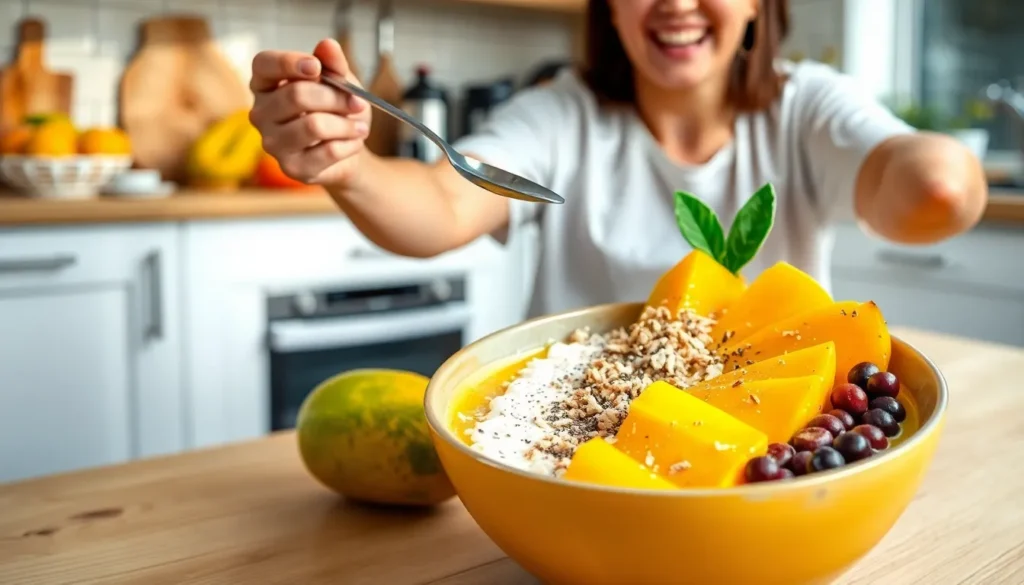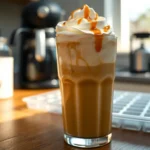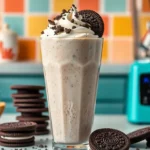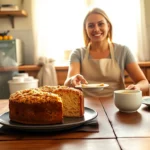When we think of tropical paradise in a bowl, nothing beats a vibrant mango smoothie bowl. This Instagram-worthy breakfast combines the creamy sweetness of ripe mangoes with thick, spoon-able goodness that’s both nutritious and utterly satisfying. We’ve perfected this recipe to deliver restaurant-quality results right in your kitchen.
What makes our mango smoothie bowl special is its perfect balance of flavors and textures. The natural sweetness of mangoes pairs beautifully with creamy banana and coconut, creating a base that’s rich enough to hold your favorite toppings without being overly heavy. It’s packed with vitamins, fiber and healthy nutrients that’ll fuel your morning.
We’ll show you exactly how to achieve that thick, ice cream-like consistency that makes smoothie bowls so addictive. With just five simple ingredients and endless topping possibilities, you’ll have a gorgeous breakfast that tastes as amazing as it looks. Get ready to transform your morning routine with this tropical treat.
Ingredients
We’ve carefully selected each ingredient to create the perfect creamy base and provide endless topping possibilities. Our mango smoothie bowl combines tropical flavors with nutritious elements that deliver both taste and health benefits.
For the Smoothie Base
- 2 cups frozen mango chunks
- 1 large frozen banana sliced
- 1/2 cup coconut milk full-fat canned
- 2 tablespoons honey or maple syrup
- 1 tablespoon lime juice freshly squeezed
For the Toppings
- 1/4 cup fresh mango diced
- 2 tablespoons coconut flakes toasted
- 1/4 cup granola
- 2 tablespoons chia seeds
- 1/4 cup fresh berries blueberries or strawberries
- 2 tablespoons sliced almonds
- 1 tablespoon hemp hearts
- Fresh mint leaves for garnish
Equipment Needed
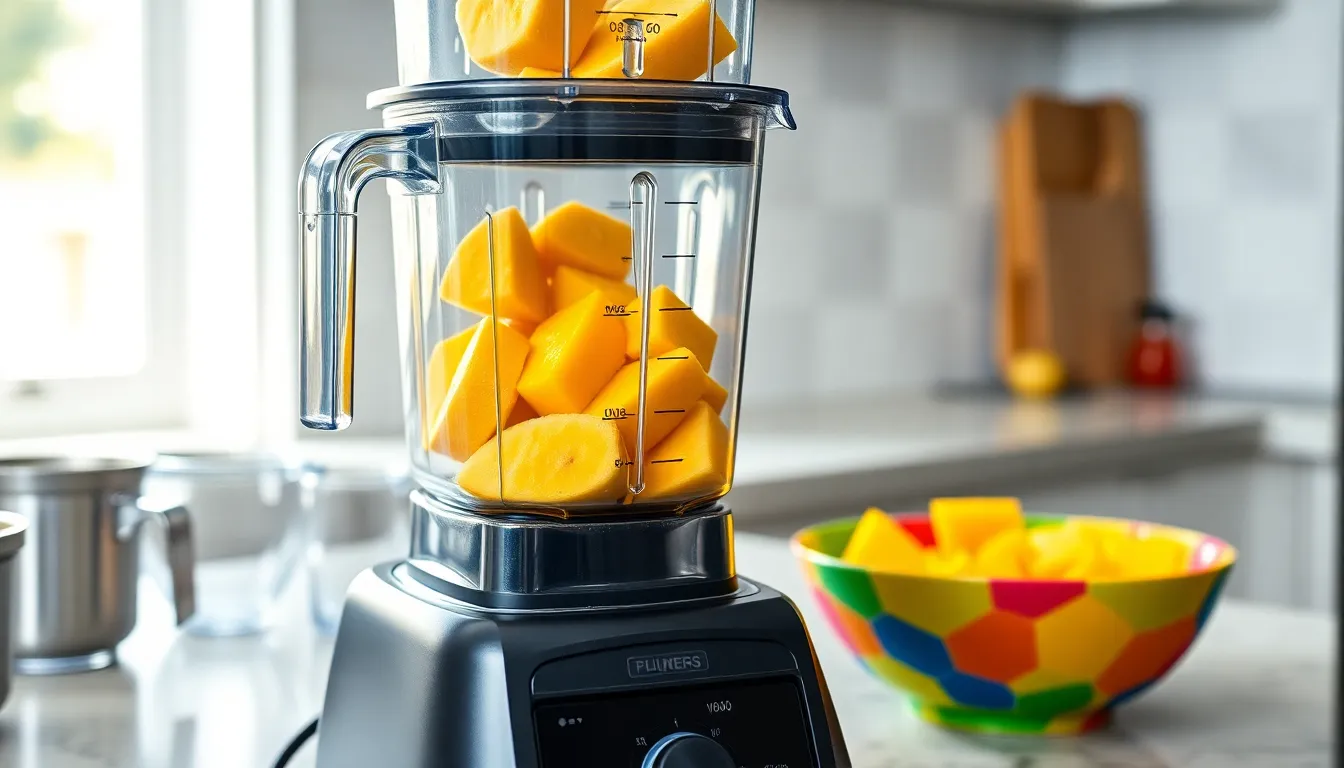
Creating our perfect mango smoothie bowl requires minimal equipment to achieve that thick, creamy consistency we’re after. We need a high-powered blender as our primary tool to transform frozen ingredients into a smooth, ice cream-like texture.
Blender (preferably high-powered) serves as the cornerstone of our smoothie bowl preparation. A powerful blender ensures we can properly break down frozen mango chunks and banana without leaving any unwanted lumps. The motor strength becomes crucial when working with frozen ingredients that require more force to blend smoothly.
Standard blenders can work for this recipe, though we may need to stop and scrape down the sides more frequently. High-powered models like Vitamix or Blendtec make the process more efficient and deliver consistently smooth results. We recommend using the tamper tool if your blender includes one to help move ingredients toward the blades.
Beyond our blender, we’ll want to have measuring cups ready for portioning our ingredients accurately. A sturdy serving bowl completes our equipment list, giving us the perfect vessel to showcase our tropical creation and arrange our colorful toppings attractively.
Instructions

Creating this tropical smoothie bowl requires just a few simple steps to achieve that perfect thick consistency. We’ll walk you through each stage to ensure your bowl turns out creamy and delicious.
Prep the Mango
Fresh or frozen mango works beautifully for this recipe, with frozen pieces helping create that coveted creamy texture we love. When using fresh mango, we recommend peeling and chopping it into uniform chunks for easier blending. Freezing these fresh chunks beforehand gives you the same consistency benefits as store-bought frozen mango. The frozen fruit eliminates the need for ice while maintaining that thick, spoonable texture that makes smoothie bowls so satisfying.
Blend the Smoothie Base
Add 2 cups of frozen mango, 1 frozen sliced banana, and 1 cup of coconut milk to your high-powered blender. We start blending on low speed, gradually increasing to high to break down the frozen ingredients smoothly. The mixture should be thick enough to hold toppings without them sinking in. Add small amounts of cold water only if necessary to help the blender move the ingredients. Stop periodically to scrape down the sides of the blender, ensuring all pieces blend evenly into that signature ice cream-like consistency.
Prepare Your Toppings
Setting aside extra mango chunks while prepping creates beautiful, colorful toppings for your finished bowl. Fresh or dried shredded coconut adds delightful texture contrast against the smooth base. Chia seeds provide a nutritious boost with their omega-3 fatty acids and protein content. Consider preparing sliced almonds, fresh raspberries, strawberries, or blueberries to create visual appeal and additional flavor layers. Having all toppings ready before assembling prevents the smoothie base from melting while you prepare garnishes.
Assemble the Smoothie Bowl
Pour the thick smoothie base into a chilled bowl, using a spoon to create a smooth, even surface. Start with your prepared mango chunks, arranging them in colorful clusters across the surface. Sprinkle shredded coconut and chia seeds evenly over the base for balanced nutrition in every bite. Add remaining toppings like sliced almonds or berries in decorative patterns that make your bowl Instagram-worthy. Serve immediately while the base maintains its thick, creamy texture for the best eating experience.
Directions for Perfect Consistency
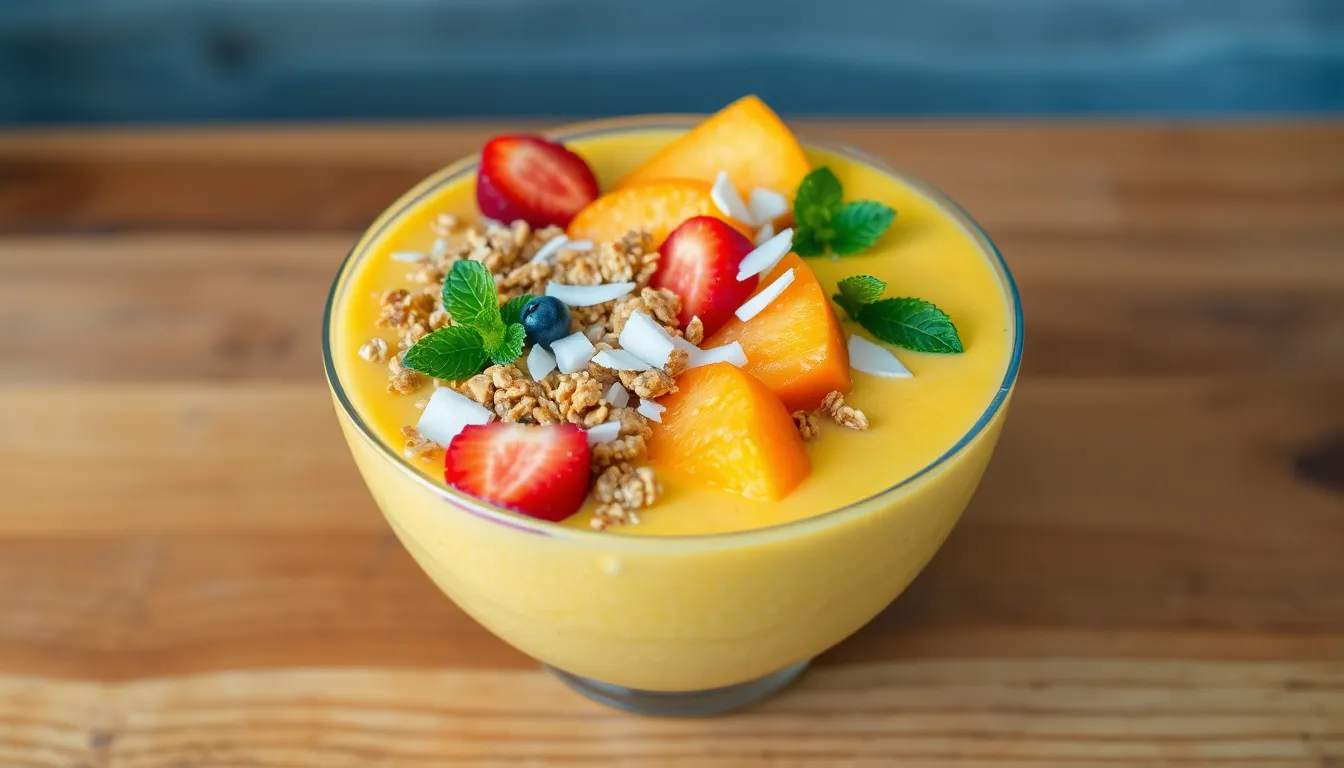
Achieving that perfect scoopable texture requires attention to exact blending techniques and ingredient ratios. We start by adding our frozen mango chunks directly to the high-powered blender along with the optional Greek yogurt for enhanced creaminess. The frozen fruit serves as the foundation for that thick consistency we’re after.
Next we pour in our chosen liquid gradually, starting with just 1/2 cup to maintain control over the final texture. Coconut milk creates the richest base while regular milk offers a lighter option. We blend on high speed for approximately 1 minute, pausing to scrape down the sides of the blender when necessary.
Monitoring the mixture during blending helps us achieve optimal results. The smoothie should coat the back of a spoon and hold its shape when scooped. If our blend appears too thick, we add liquid one tablespoon at a time while the blender runs. Conversely, if the consistency seems too thin, we incorporate additional frozen mango chunks.
Frozen ingredients remain essential throughout this process since fresh fruit creates a watery texture that won’t support toppings properly. We ensure every piece of frozen mango gets completely incorporated to eliminate any remaining lumps. The final mixture should appear smooth and creamy with no visible fruit pieces.
Temperature control matters significantly for maintaining that perfect bowl consistency. We work quickly once blending completes to prevent melting. Our smoothie base should feel cold to the touch and maintain its thick structure when transferred to serving bowls.
The ideal consistency allows us to create a smooth surface with the back of a spoon while remaining thick enough that toppings stay in place rather than sinking. This perfect balance transforms our smoothie from a drinkable treat into a satisfying bowl meal that holds its shape from first bite to last.
Make-Ahead Tips
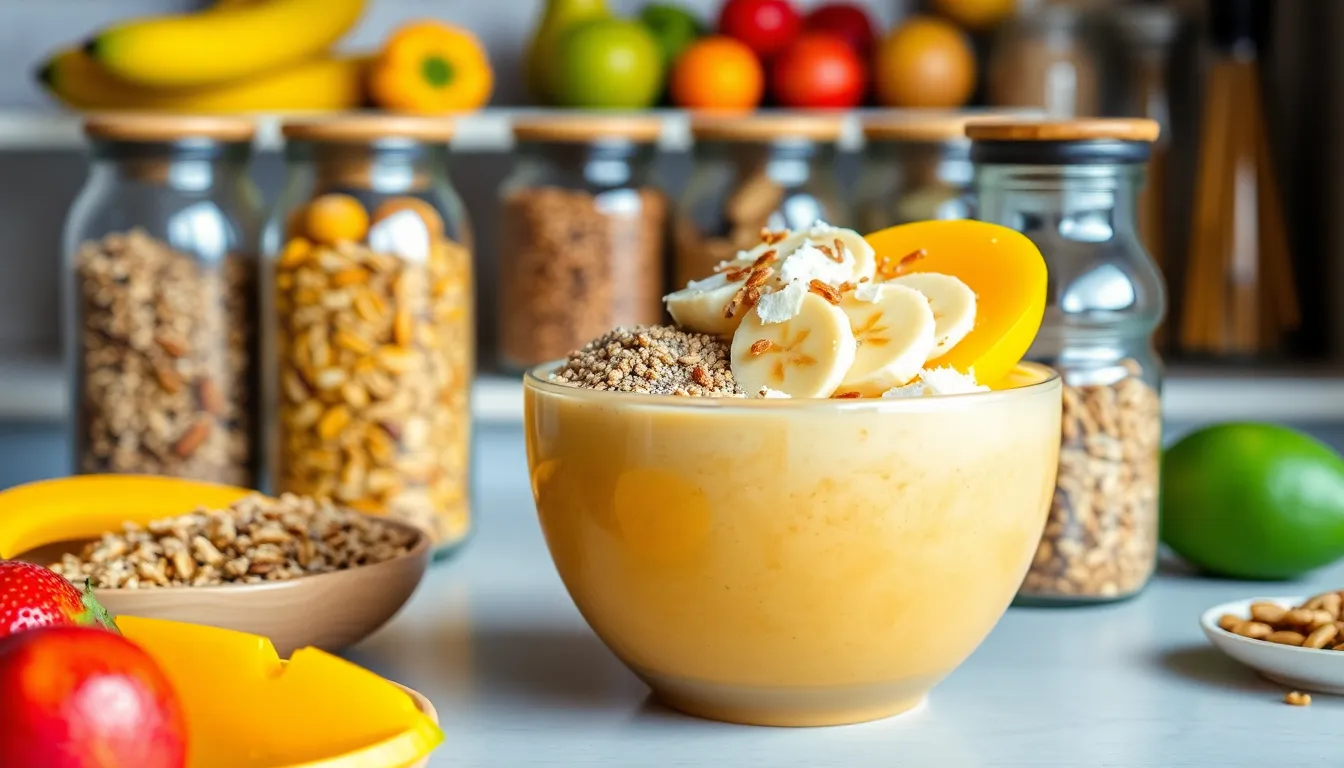
Preparing mango smoothie bowls ahead of time transforms busy mornings into stress-free breakfast experiences. We recommend freezing your fruit components in advance to ensure the perfect texture every time you blend.
Freeze Ingredients in Advance
Slice bananas and cut mango chunks into uniform pieces before placing them in freezer-safe bags. Store frozen mango and banana slices for up to three months while maintaining optimal flavor and nutritional value. We suggest portioning individual servings into separate containers to streamline your morning routine.
Prepare Toppings the Night Before
Chop nuts, measure chia seeds, and slice fresh fruits during evening meal prep sessions. Store prepared toppings in airtight containers in the refrigerator to maintain freshness and crunch. Toasted coconut flakes and granola can be prepared in larger batches and stored at room temperature in sealed jars.
Blend and Store the Base
Create the smoothie base up to 24 hours in advance by blending frozen mango, banana, and your chosen liquid until thick and creamy. Transfer the blended mixture to covered containers and refrigerate overnight. The base will maintain its smooth consistency and vibrant color when properly stored.
Morning Assembly Strategy
Remove the pre-blended base from the refrigerator 5-10 minutes before serving to achieve the ideal scoopable texture. Add fresh toppings immediately before eating to preserve their individual textures and prevent soggy results. We find that arranging toppings in colorful sections creates an Instagram-worthy presentation while keeping prep time minimal.
| Prep Method | Time Saved | Storage Duration |
|---|---|---|
| Pre-cut frozen fruit | 5-7 minutes daily | 3 months |
| Pre-blended base | 10 minutes daily | 24 hours |
| Prepared toppings | 3-5 minutes daily | 3-5 days |
Storage Instructions
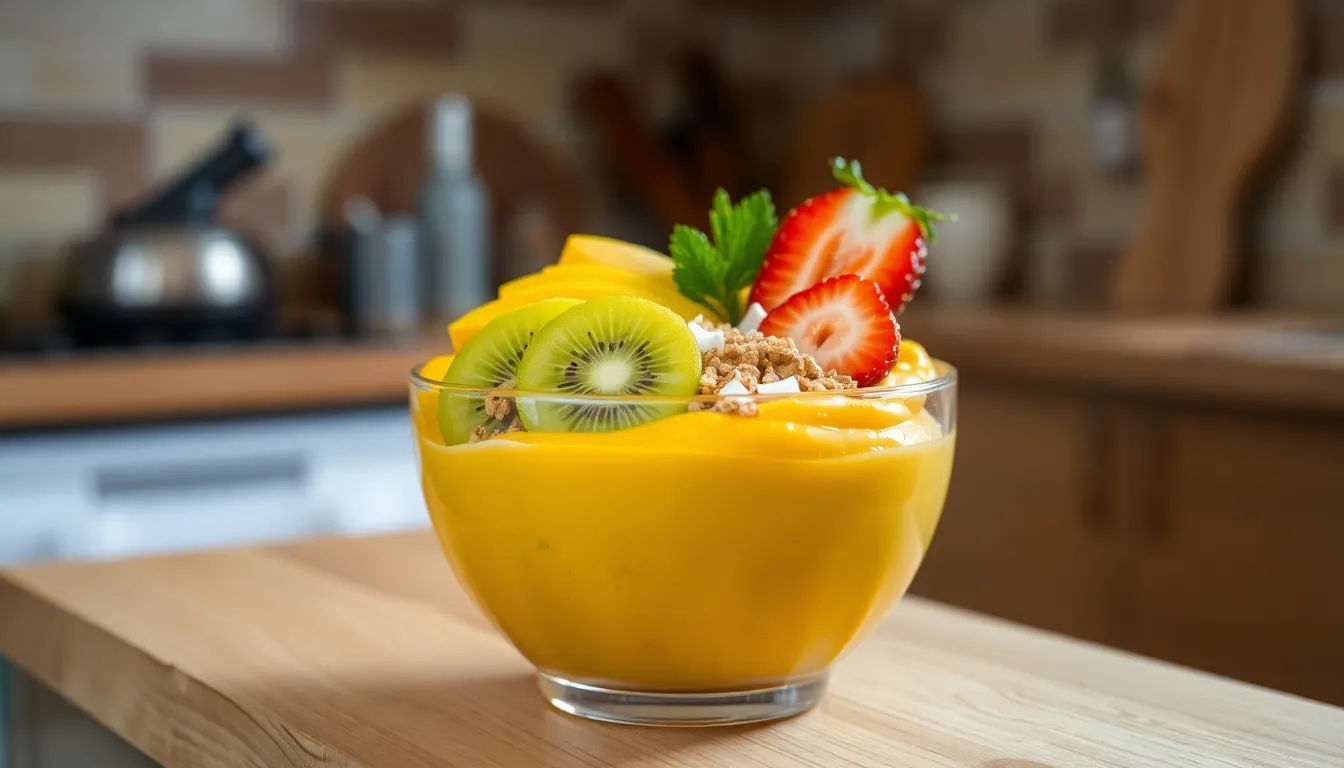
We understand that properly storing your mango smoothie bowl ensures you can enjoy this tropical treat even when time is limited. Our storage methods preserve both flavor and nutritional value while maintaining the perfect texture.
Refrigerate prepared smoothie base in an airtight container for up to 24 hours. We recommend glass containers as they prevent flavor absorption and keep the mixture fresh. The smoothie will naturally thicken in the refrigerator due to the frozen fruit base.
Freeze individual portions of the blended smoothie in freezer-safe containers or silicone molds for longer storage. We suggest portioning the mixture into single-serving sizes before freezing. When ready to enjoy, transfer frozen portions to the refrigerator to defrost gradually.
Stir the mixture after refrigeration or defrosting to recombine ingredients that may have separated. We find that a gentle folding motion works best to restore the smooth consistency. If the texture becomes too thick, gradually add small amounts of coconut water or your preferred liquid until reaching the desired consistency.
Prepare ingredient packs by pre-portioning frozen mango chunks, banana slices, and pineapple pieces into individual freezer bags. We recommend labeling each pack with the date and contents. This method allows you to blend fresh smoothie bowls quickly without measuring ingredients each time.
Store fresh toppings separately to maintain their texture and prevent soggy results. We keep granola in airtight containers at room temperature, while fresh fruits should remain refrigerated until serving. Coconut flakes and chia seeds maintain their quality when stored in sealed containers away from moisture.
| Storage Method | Duration | Best Practices |
|---|---|---|
| Refrigerated smoothie base | Up to 24 hours | Airtight glass container |
| Frozen portions | Up to 3 months | Individual serving sizes |
| Fresh toppings | 3-5 days | Separate containers |
| Prepared ingredient packs | Up to 6 months | Labeled freezer bags |
Serving Suggestions
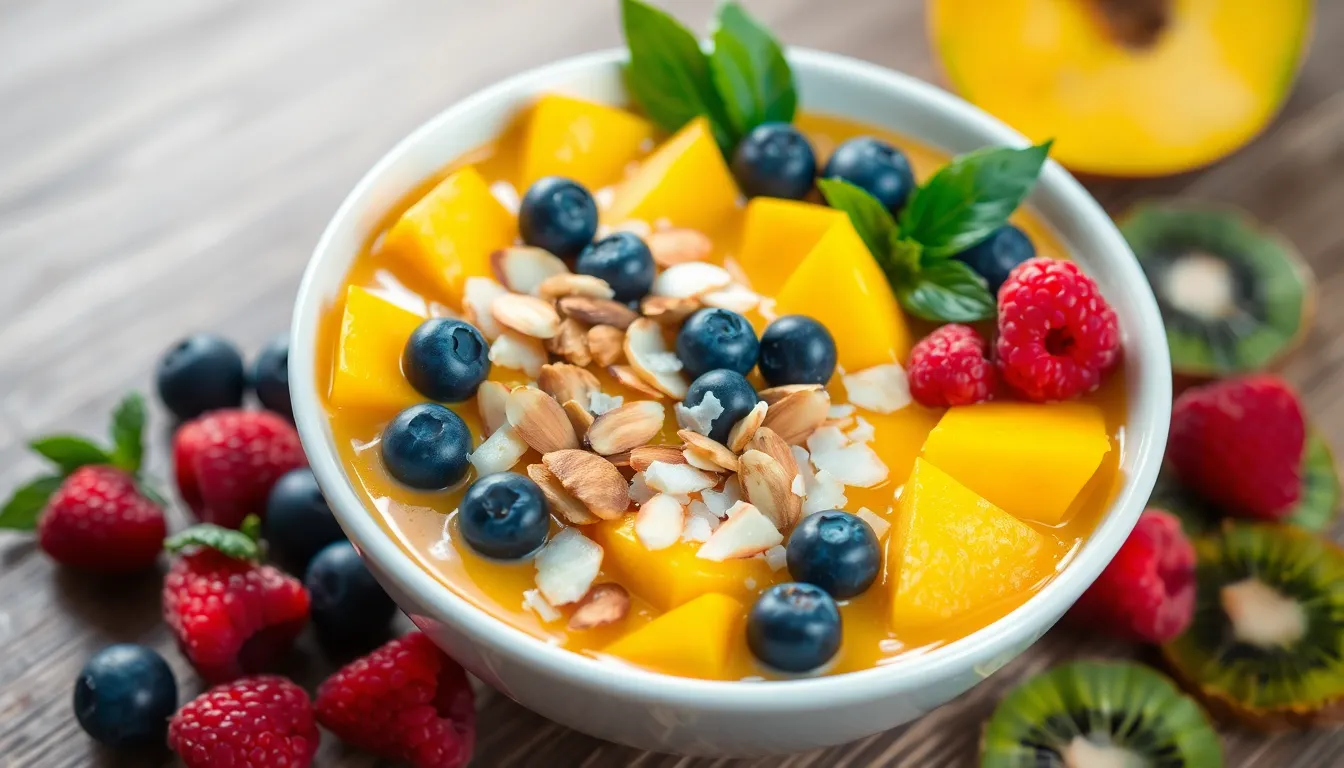
We recommend serving your mango smoothie bowl immediately after blending for optimal taste and texture. The fresh preparation ensures the mixture maintains its thick, creamy consistency that perfectly holds toppings without becoming watery.
Essential Toppings for Maximum Appeal
Fresh fruit transforms our basic smoothie bowl into a vibrant breakfast masterpiece. We suggest arranging fresh mango chunks and pineapple pieces around the bowl’s edge for tropical sweetness. Blueberries provide beautiful color contrast while adding antioxidants to each spoonful.
Textural elements create the satisfying crunch that makes smoothie bowls so appealing. We love sprinkling sliced almonds or macadamia nuts across the surface for healthy fats and protein. Chia seeds, hemp seeds, or flax seeds offer nutritional benefits while adding subtle texture variation.
Creative Presentation Ideas
Coconut flakes bring tropical flair when scattered generously over the smoothie base. We recommend toasting them lightly for enhanced flavor and golden color. Granola clusters provide substantial crunch that pairs beautifully with the smooth mango base.
Berry lovers should consider raspberries or strawberries for tartness that balances the mango’s natural sweetness. Kiwi slices create stunning visual appeal with their bright green color and unique pattern.
Nutritional Enhancement Options
We suggest drizzling nut butter over toppings for added protein and richness. Almond butter or cashew butter complement the tropical flavors exceptionally well. Protein powder can be mixed directly into the smoothie base for fitness enthusiasts seeking post-workout nutrition.
Serving Timing and Temperature
The bowl should be consumed within 15 minutes of preparation to maintain its ideal consistency. We find that longer waiting periods cause the mixture to soften and lose its signature thick texture. Keep toppings chilled until serving time to preserve freshness and prevent premature melting of the smoothie base.
Nutritional Benefits
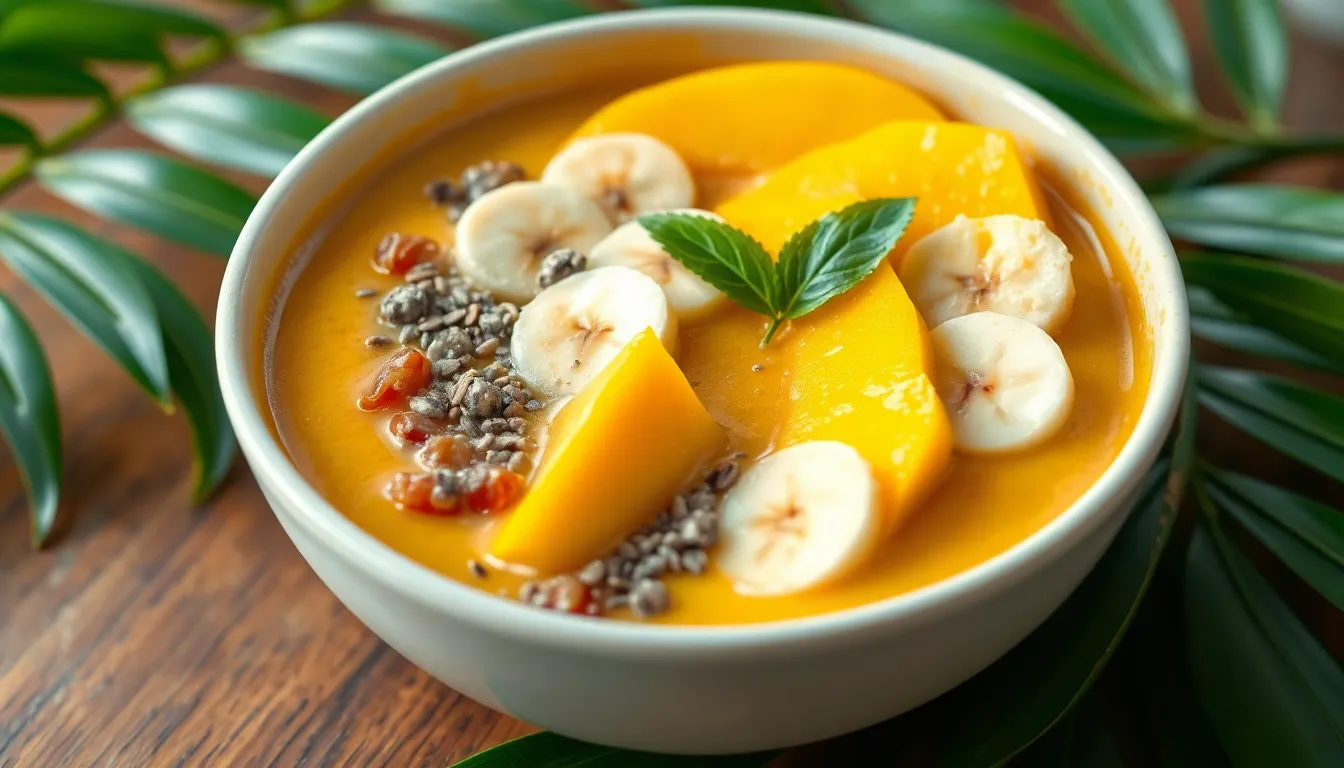
Our mango smoothie bowl delivers an impressive array of essential nutrients that make it an ideal breakfast choice. This tropical bowl provides approximately 3.4 grams of protein per serving, supporting muscle maintenance and sustained energy levels throughout your morning. The protein content comes primarily from the coconut yogurt or kefir and fortified plant-based milk we use in the base.
Fiber content reaches about 6 grams per serving, promoting healthy digestion and helping you feel satisfied longer. This substantial fiber amount comes from the whole fruit ingredients, particularly the mango and banana, which contribute both soluble and insoluble fiber to support your digestive system.
Vitamin C and antioxidants pack a powerful punch in every bowl we create. Mangoes naturally contain high levels of vitamin C, which supports immune function and helps protect your cells from oxidative damage. These antioxidants work together to combat free radicals and may help reduce inflammation in your body.
Calcium support comes from the fortified plant-based milk we recommend in our recipe. This essential mineral contributes to bone health and proper muscle function, making our smoothie bowl a smart choice for maintaining strong bones throughout life.
Anti-inflammatory properties shine through both the mango and kefir components when you choose kefir as your yogurt option. These ingredients work together to promote gut health and may help reduce inflammation markers in your body.
| Nutritional Component | Amount per Serving | Health Benefits |
|---|---|---|
| Calories | 236 | Sustained energy |
| Protein | 3.4g | Muscle maintenance |
| Fiber | 6g | Digestive health |
| Total Fat | 2.7g | Healthy fats |
| Carbohydrates | 57g | Quick energy |
| Potassium | 405mg | Heart health |
The complete nutritional profile shows our mango smoothie bowl contains 236 calories per serving with 2.7 grams of total fat and 57 grams of carbohydrates. Potassium levels reach 405 milligrams, supporting heart health and proper muscle function. While vitamin D and iron content remain minimal, the overall nutrient density makes this bowl an excellent foundation for a healthy breakfast routine.
Variations and Substitutions
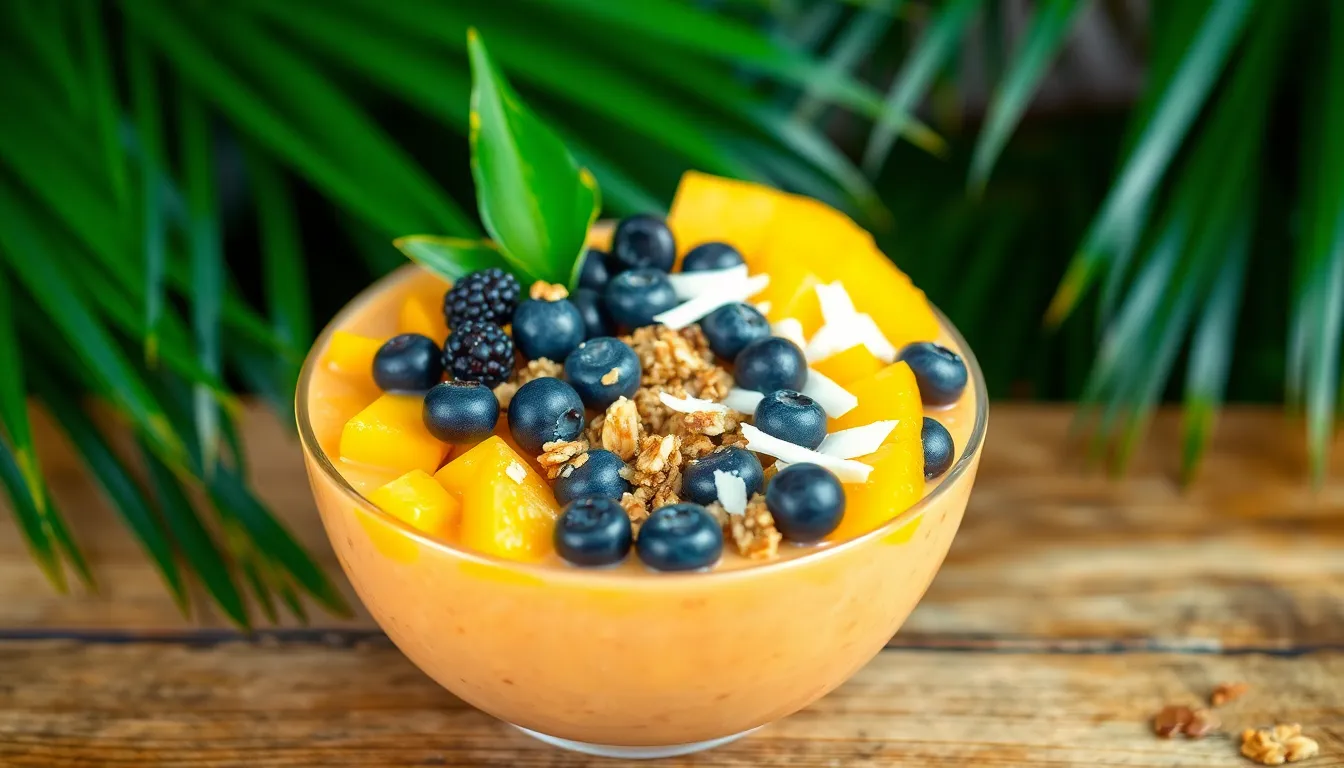
We can easily customize this mango smoothie bowl recipe to suit different tastes and dietary preferences. These adaptations allow us to create unique flavor profiles while maintaining the satisfying texture and nutritional benefits.
Tropical Twist
We love improving the tropical experience by adding frozen pineapple chunks to our mango base. This combination creates a vibrant flavor that transports us straight to paradise with every spoonful. Using coconut water or full-fat coconut milk as our liquid base intensifies the tropical essence while providing natural electrolytes.
For toppings we recommend fresh pineapple chunks, mango slices, and juicy blueberries to create beautiful color contrast. Toasted coconut flakes add delightful crunch while chai spiced granola brings warm aromatic notes that complement the fruit beautifully. This variation delivers complex flavors that make our breakfast feel like a vacation treat.
Protein-Packed Version
We can easily boost the protein content by incorporating Greek yogurt into our smoothie base. Adding 24 ounces of low-fat Greek yogurt creates an incredibly creamy texture while providing substantial protein to keep us satisfied longer. This addition transforms our smoothie bowl into a more filling meal option.
For those preferring plant-based proteins we suggest adding one scoop of our favorite protein powder during the blending process. Vanilla or tropical flavored protein powders work exceptionally well with mango’s natural sweetness. We find that starting with less liquid when adding protein powder helps maintain the thick consistency we desire.
Low-Sugar Alternative
We can significantly reduce the sugar content by choosing unsweetened almond milk or coconut milk as our liquid base. Eliminating added sweeteners like honey or maple syrup allows the natural fruit sugars to shine through while keeping calories in check. This approach creates a more balanced flavor profile that highlights the mango’s inherent sweetness.
Instead of traditional granola we recommend topping our bowl with raw almonds, chia seeds, hemp hearts, or pumpkin seeds for added nutrition without excess sugar. Fresh berries provide natural sweetness and antioxidants while maintaining the vibrant appearance we love. This variation delivers all the satisfaction of our original recipe while supporting blood sugar stability.
Troubleshooting Tips
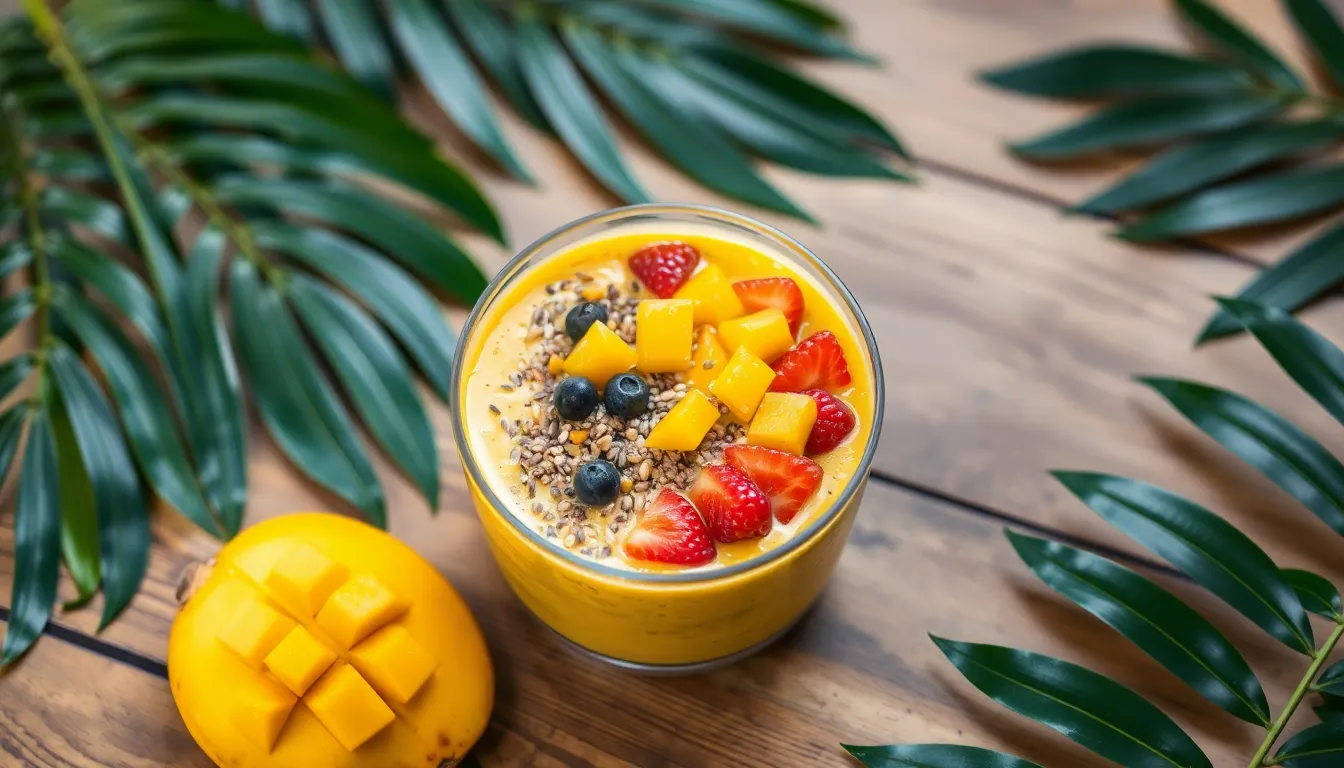
Even with our simple mango smoothie bowl recipe, you might encounter a few common challenges that can affect the final texture and taste. We’ve compiled our most effective answers to help you achieve that perfect smoothie bowl consistency every time.
Smoothie Texture Too Thick
When your smoothie becomes too thick to blend properly, adding liquid gradually solves the problem. We recommend starting with just one tablespoon of milk or water at a time. Pour the liquid down the sides of the blender to help the frozen ingredients move freely. Coconut water works exceptionally well for maintaining tropical flavors while thinning the mixture.
Smoothie Texture Too Watery
A watery smoothie won’t hold your beautiful toppings and defeats the purpose of a smoothie bowl. Adding more frozen fruit immediately thickens the consistency. Frozen banana pieces work best as natural thickeners. Greek yogurt or nut butter also transforms thin smoothies into creamy, scoopable textures. We suggest adding these thickening agents one tablespoon at a time until you reach the desired consistency.
Chunky or Grainy Texture Issues
Achieving smooth, creamy results requires proper blending technique. High-performance blenders like Vitamix benefit from using the tamper tool to push ingredients toward the blades. Start blending on low speed and gradually increase to high. Stop the blender every 30 seconds to scrape down the sides and redistribute ingredients. Frozen mango pieces should be slightly softened before blending for optimal smoothness.
Smoothie Bowl Won’t Hold Toppings
Toppings that sink into your smoothie indicate the base is too thin. We recommend using at least 70% frozen ingredients in your blend. Adding a tablespoon of chia seeds during blending creates natural thickening without altering the tropical taste. Let the smoothie bowl sit for 2-3 minutes after pouring to allow it to firm up slightly before adding toppings.
Conclusion
This tropical mango smoothie bowl brings restaurant-quality nutrition and flavor straight to your kitchen. We’ve shown you how simple ingredients can create something truly special when combined with the right techniques.
The beauty of this recipe lies in its flexibility – whether you’re looking for a protein boost or want to experiment with different tropical flavors the foundation remains foolproof. With our troubleshooting tips you’ll master the perfect consistency every time.
Start your morning with this vibrant nutritious bowl and you’ll understand why it’s become our go-to breakfast. The combination of natural sweetness creamy texture and endless topping possibilities makes every bite an adventure worth waking up for.
Frequently Asked Questions
What ingredients do I need for a basic mango smoothie bowl?
You need just five simple ingredients: frozen mango chunks, frozen banana, coconut milk, honey or maple syrup, and lime juice. These create the perfect base with a thick, ice cream-like consistency that’s ideal for holding toppings.
What equipment is essential for making smoothie bowls?
A high-powered blender is crucial for achieving the smooth, creamy texture needed for smoothie bowls. You’ll also need measuring cups for accurate portions and a sturdy serving bowl for presentation. Standard blenders may struggle with frozen ingredients.
How do I achieve the perfect thick consistency?
Use frozen ingredients rather than fresh ones to avoid watery texture. Blend gradually, starting with less liquid and adding more as needed. The mixture should be thick enough that toppings don’t sink in but still smooth and creamy.
Can I make smoothie bowls ahead of time?
Yes! You can freeze fruit components in advance and prepare toppings beforehand. However, the assembled smoothie bowl is best consumed immediately for optimal taste and texture. Store the base separately if making ahead.
What are the best toppings for mango smoothie bowls?
Popular toppings include fresh mango pieces, toasted coconut flakes, granola, chia seeds, fresh berries, sliced almonds, and fresh mint leaves. Arrange them creatively for an Instagram-worthy presentation that adds texture and flavor variety.
How can I customize my smoothie bowl for different dietary needs?
Try adding frozen pineapple for a tropical twist, Greek yogurt or protein powder for extra protein, or use unsweetened almond milk for a low-sugar version. Each variation maintains nutritional benefits while offering unique flavor profiles.
What should I do if my smoothie bowl is too thick or too thin?
If too thick, gradually add small amounts of liquid while blending. If too thin, add more frozen fruit or a small amount of Greek yogurt. Always blend in short bursts to maintain control over consistency.
What are the main nutritional benefits of mango smoothie bowls?
Mango smoothie bowls provide essential nutrients including protein, fiber, vitamin C, and potassium. They offer sustained energy, support immune function, and contribute to overall health while satisfying your sweet tooth naturally.

